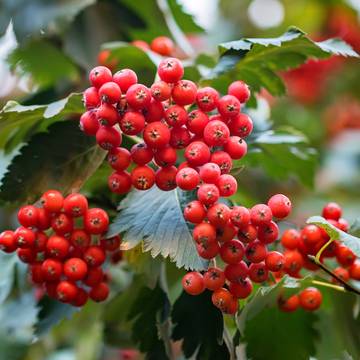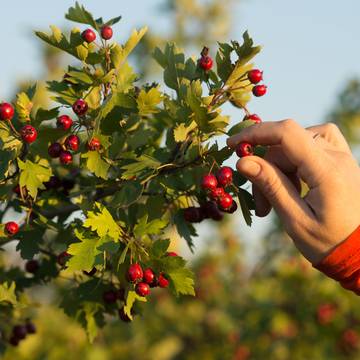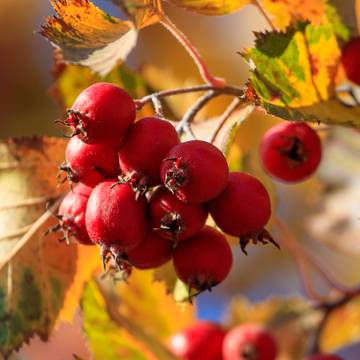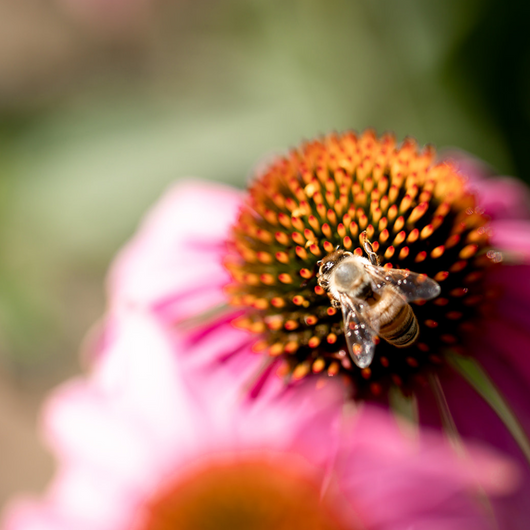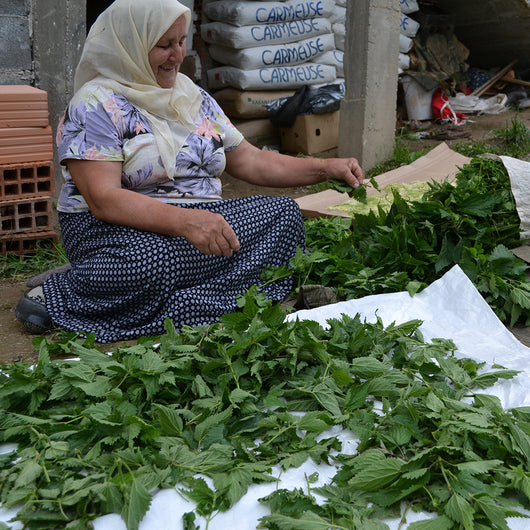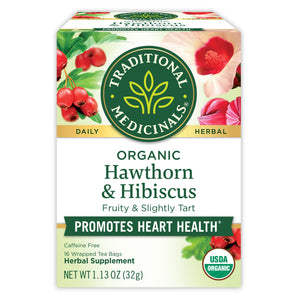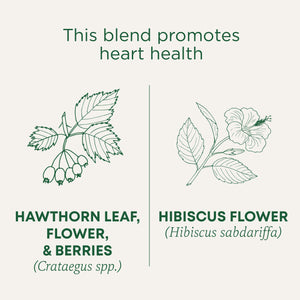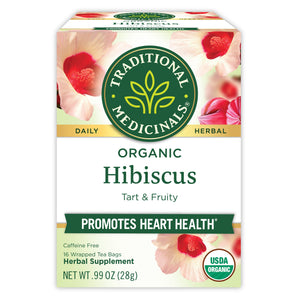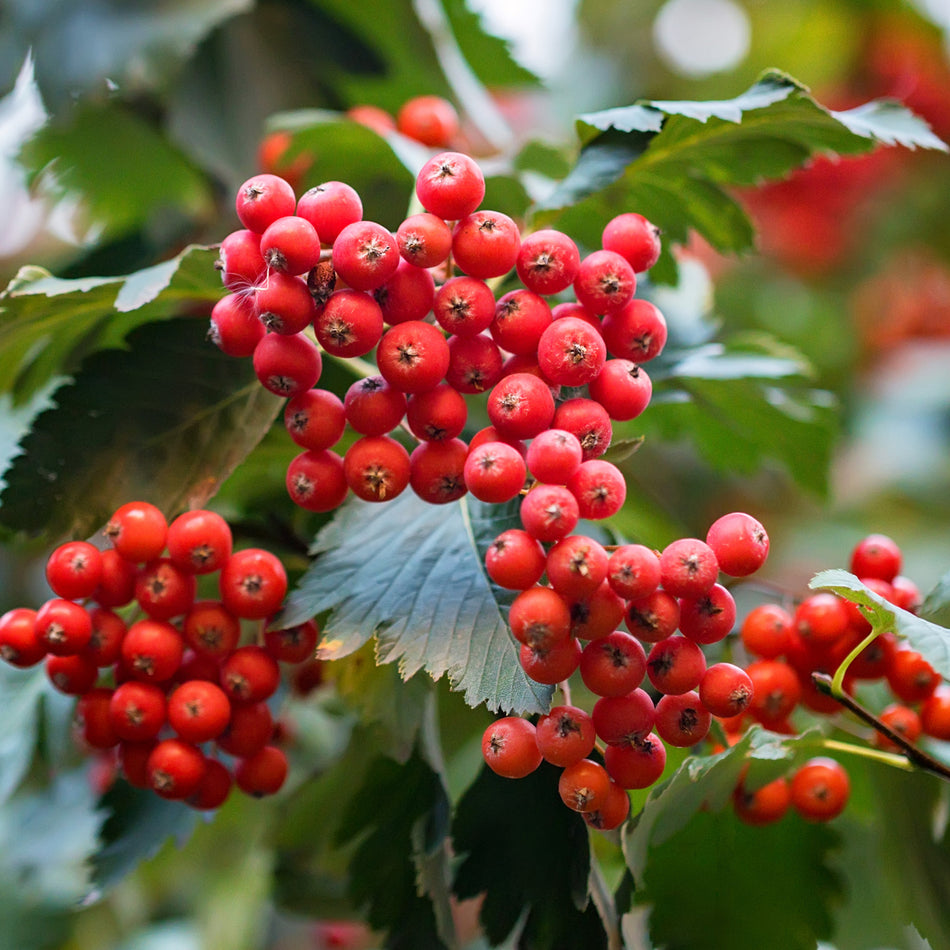
Hawthorn
Crataegus spp.Hawthorn’s leaves and crimson berries have been used for centuries to support the cardiovascular system and is one of the most popular remedies for heart health across Europe.*
A thorny berry with a soft spot for the heart.
What are the Benefits of Hawthorn?
Hawthorn notably contains both flavonoids and quercetin. As herbalists, we use hawthorn leaves and flowers in our formulas to support heart health and overall circulation.* This plant is truly a cardiotonic that’s ideal for those with an active lifestyle and those wishing to give their heart a little extra love.
The whole plant is often used in herbal medicine, including leaves, flowers, and berries. We like to use the leaves and berries in our teas to get the benefits of the whole plant. Because of the juicy and tart taste of the berries, they’re a great candidate for herbal foods. There are many traditional culinary preparations, including wine, jam, syrups, and vinegars.
Folklore & Historical Use of Hawthorn
The species name Crataegus is said to come from the Greek word krátaios, which roughly translates to hard, strong, and has always been there. Some say it was the plant behind the crown of thorns placed upon the head of Jesus. Folklore aside, it’s unarguably been used for thousands of years and around the globe as a heart tonic, and in many different herbal medicine traditions.
Hawthorn’s medicinal properties were first documented by Dioscorides, back in the 1st century A.D. Other Greek doctors, including Pliny, and Galen also recorded its benefits. Around 659 A.D. Tang-Ben-Cao recorded the use of a Chinese hawthorn, which in modern-day times is used in Eastern Medicine for digestion and heart health.*
Beyond herbal medicine, hawthorn has also played a role in herbal folklore to ward off evil spirits. To shield newborn babies from harm, the Romans would hang hawthorn sprigs over cradles. Pagans strung hawthorn flowers into garlands for use in May Day celebrations. Early Christians hung it over doorways for protection during the Middle Ages.
Botanical Description & Habitat
Native to Europe, Asia, and North America, hawthorn often gathers into thick hedgerows, and is often used as a living fence and for its strength to enclose pastures and meadows. It’s a shrub that grows best with lots of sun and well-drained soil. Hawthorn tends to thrive in the East Coast of the U.S., though it can be found growing across North America, generally in more temperate climates. Its pink and white flowers come in spring which make way for its scarlet red berries to fruit in the late summer.
When To Use Hawthorn
Take regularly for cardiovascular maintenance.
The Business of Sustainable Plants
Our business is rooted in plants, and for us, it’s a business imperative that we care for the ecosystems where these plants live and thrive. We believe that everything is interconnected, which means supporting ecosystems and the farmers and collectors who harvest and gather our herbs. Finding opportunities to reduce or eliminate emissions at the source, we support organic and regenerative farming practices as well as voluntary certifications like Organic and FairWild. These ensure the absence of pesticides, herbicides, as well as the ongoing sustainability of wild collection, and the health and livelihoods of the collectors who forage. Josef Brinckmann, Traditional Medicinals’ Research Fellow, Medicinal Plants and Botanical Supply, asserts, “Everyone has a role to play in preserving biological diversity. One way of doing that is by equitably supporting the local people to serve as stewards of the land.”
It Starts with Organic
We choose to source organic because we believe in the positive impacts it has on environmental sustainability, biodiversity, and overall ecosystem health. Organic helps us increase transparency while prioritizing consumer well-being and farmer success, which is key to producing the high-quality herbs we source. In 2021, we procured 2.73 million pounds of certified organic herbs, over 99.7% of our total botanical herbs purchased. Volumes were down slightly from FY20 due to timing of inventories received.
The impact from organic farming creates a vital ecosystem through improved soil health, water quality, pollinator habitats, and biodiversity. Organic farms also have increased carbon sequestration potential through long-term carbon storage in the soil, helping to mitigate climate change.
One of the benefits of organic that we most value is farmer health. We care deeply about the people who produce our herbs, ensuring that they are not exposed to synthetic chemicals found in conventional agriculture.
Fair Trade
We believe that everyone deserves a fair wage for hard work. That’s one of the reasons why we’re committed to fair trade. Traditional Medicinals® is a registered Fair Trade “brand holder”, “licensee” and “manufacturer,” and our products are certified by Fair Trade USA, an independent third-party certifier. We were an early adopter of Fair Trade, having launched our first fair trade tea product in 1998, just one year after Fairtrade International (FLO) was established. We continue to work closely with our network of producers to help them to implement fair trade standards and get certified.
Hawthorn & Hibiscus Tea
Additional Information
Important Precautions:
Consult your healthcare practitioner prior to use if you have a serious heart condition; if you are taking cardiac glycosides such as digitalis/digoxin or blood pressure medication, or if you are pregnant or breastfeeding.
Legal Disclaimer:
The information and other content in this article are designed to provide a general overview of the botany, cultural history, and traditional uses of this herb. It is not intended and should not be construed as health advice. Every person is unique and you should consult with your health care provider before using any herbal product or supplement.

